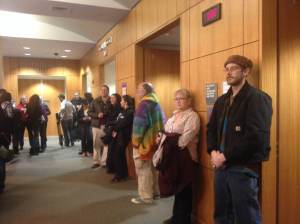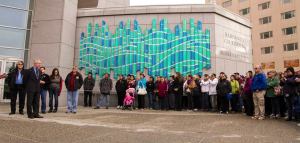 Edgar Henry is originally from Tanana, and spent his earliest years being raised along the Yukon, with strong traditional Athabascan values, learning to hunt and live with the land. Today he is the proud father of a seven year old girl, who has him pretty wrapped around her finger. He says she is “the boss.”
Edgar Henry is originally from Tanana, and spent his earliest years being raised along the Yukon, with strong traditional Athabascan values, learning to hunt and live with the land. Today he is the proud father of a seven year old girl, who has him pretty wrapped around her finger. He says she is “the boss.”
He spent the night of the murder with George (see him on George’s timeline HERE) along with his brother, the late Patrick Henry. Edgar drank heavily, alongside George. However Patrick did not drink at all, and was very conscious of time that night. He was absolutely certain on the timeline of the group’s movements, and knew George’s whereabouts from well before the time of the murder until after 3am. Edgar’s memory was not as clear.
When police interviewed him, as with others who you can read about here, here, and here, they actually interrogated him. Like with others, they interrogated him with the Reid Method of interrogation, a methodology so likely to produce trauma and false confessions that it is illegal in many countries (read about this interrogation method HERE). It is not ever recommended for use on young people, impaired people, people whose memory is somehow corrupted, and is designed for use on suspects who the police already know are guilty of the crime.
Edgar’s interrogation was a nightmare. After hours of unrelenting questioning, threats, and lies, he agreed that he might have seen George, Marvin, Eugene, and Kevin together that night. He recanted immediately.
Below, Edgar discusses that night, the interrogation, the past, and the future in his own words.
What do you remember about that night?
Yeah, well, we were at George’s house for most the night. We drank, like, cases of beer within just a few hours, playing a drinking game. We got totally wasted. Really, I don’t remember much of the details. Like I came to for a second, and there was a whole group of us walking to the reception, a big group. And I remember walking down the stairs of the Eagle’s Hall, like a flash of it. I remember, well I guess kinda remember, being by the Eagles’ Hall. (Read about the science behind blackouts HERE).
Patrick never drank that night. My late brother was a good guy, and the kind of person that paid attention to time, too. He was with us, just watching over us. I was so wasted that night I guess I gave him like close to like 600 bucks that night, I didn’t even remember. It was the money I had to get an apartment, when I woke up I thought i got rolled or something, all my cash was gone, and then my brother gave it back to me.
That night we stayed at George’s apartment, in the morning he was all, “Man, my ankle is killing me.” He was real hurt, and he left. It was sometime that day, or maybe even later, that next day that I heard he was arrested.
What was your reaction when George was arrested?
At first when I heard he was arrested, I was just confused. I knew he was with us that night, ya know, so when I heard he was in trouble at all I just thought it didn’t make sense. When I heard that he was arrested for charges like these, man I don’t know, I was like, how could that be? How could that even be? I remember talking to my brother Patrick about it, and we just couldn’t understand how, after learning what he was in jail for and them saying it was that night, we knew it was impossible. We knew he was with us the whole night.
When did you talk to the police?
It was a long time, they (the police) kept on trying to get a hold of me. I was avoiding them, because – well, I was scared. I grew up afraid of them, and then they had just gone and done this to my bro.They told me I was, that I had no choice and was like subpeonaed and had to go. So I was scared that they would come arrest me or show up at the house or something like that.
What was it like when you did talk to the cops?
 Well I went downtown, and they took me to this room. I remember one of the guys, they kept on going in and out of the room, and the interrogation room is really, really small. I sat down at this small little space, there was just one chair in the that corner I sat in. I was literally cornered. These two officers sitting basically knee to knee with me, like they were, just had me completely cornered. They kept me two, three hours or more. I had never been through anything like that before, and I never, ever want to be in that position again. I believed they were going to arrest me, they had just done it to George.
Well I went downtown, and they took me to this room. I remember one of the guys, they kept on going in and out of the room, and the interrogation room is really, really small. I sat down at this small little space, there was just one chair in the that corner I sat in. I was literally cornered. These two officers sitting basically knee to knee with me, like they were, just had me completely cornered. They kept me two, three hours or more. I had never been through anything like that before, and I never, ever want to be in that position again. I believed they were going to arrest me, they had just done it to George.
It was like they were, ya know, telling me pretty much – they were scaring me is what they were doing, saying like maybe you were there, maybe you murdered him, things like that. They way they were questioning me, too, they were asking the same questions over and over and over again, but the question was just asked in different ways and the way they were asking it was pretty much only one way to answer it, which is what they wanted to hear. For hours I kept telling them the plain truth, and they were telling me, “you can’t black out, alcohol doesn’t black you out,” and they were trying to make it sound like I was lying. Then the one was coming in and out, in and out, and lying and telling me that my story was different than my brother’s, that I was going to get Patrick in trouble if I didn’t answer the way they were telling me to. I, I was just really, very scared.
Eventually, I don’t know, I think it was, when I first started agreeing with their answers I was only saying “I guess,” or “I don’t know,” and then they just started making “I guess so” into a “yes.”
That question they kept asking, it was whether you saw these four guys together or getting into a car that night. Did you see those four guys together that night?
No, I only said “I guess so” and all that because, I don’t know, it was like some kind of trick. They would ask, ask, ask, in a different sentence, it was hours of the same question, and I knew that. I knew that the only thing was to just kind of agree, to get out. No, I didn’t see them together that night. I saw George, and that was all.
What about Patrick’s interrogation?
My brother was being questioned at the same time, for a long time too. He, though, he didn’t drink at all, he watched times, he was real sure of himself. He didn’t ever agree to their answers. I guess eventually he told them he wanted he lawyer, so they let him go.
After, after they questioned him and after the trials and all, he was really pissed off at Aaron Ring, and Kendrick, O’Bryant, and all those guys, he was like, man, these guys are racist. That they were just racist. It was so obvious, everyone knew they were not together that night. We knew. They knew. Everyone knew they didn’t do it, Patrick just, he couldn’t believe it.
What was George like back in 1997?
We would always be hanging out, I spent a lot of time with George back then. Lifting weights, sometimes I would babysit for them, just hanging out. George, he was a real good dad, his baby girl was everything to him. Real good dad. I’ve known George, cripes, since I was like 11. Since we were real kids. He’s just a good guy, always liked to joke around, and real cool. He would never do something like this, I mean I know he didn’t, but I know also that he wouldn’t.
You were scared to begin with of the police. Why?
Things back then with the police in general were just bad. I mean everyone was scared. Yeah, even one time when Patrick, when he was like 15 years old, he told me about a time he was driving his bike home and an officer pulled him over, for nothing, then the officer told him to lean against the car with his hands behind his head, and Patrick didn’t hear him, but the officer slammed his head into the car, and said, “Next time you do what I say.” And stories like that, they just happened all the time back then. So of course, of course we were scared.
You were questioned with the same method they used on George. If they had been interrogating you over the murder, do you think you would have agreed, you know, confessed?
Yeah, I do. Probably, yeah, probably. Because, it’s hard to explain, but the persistence, and the pressure, and they way they talk to you. And the way they make you feel, all in your face, making you feel like you are cornered, really you are cornered. And agreeing is the only way out. It’s all about, it is fear. Fear.
 Do you think they will be free someday?
Do you think they will be free someday?
I believe they will. Yes, they will. The word is out, people are getting more educated on this, they have been in there long enough, too long, in there for nothing. And I just, I feel it. I have had dreams about it. It’s like it’s in the air. I have no doubt, I believe they will get out.
 We were deeply saddened to receive news of Arlo Olson’s passing and further disheartened to learn that he took his own life while in custody.
We were deeply saddened to receive news of Arlo Olson’s passing and further disheartened to learn that he took his own life while in custody.































